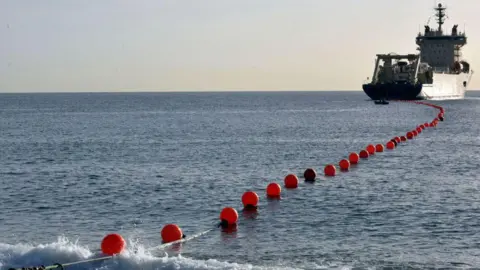In a significant development in global internet infrastructure, Meta has unveiled its ambitious plans for Project Waterworth, which involves constructing a staggering 50,000 kilometers (31,000 miles) of subsea cable. This innovative project aims to connect multiple regions including the United States, India, South Africa, and Brazil, making it the longest underwater cable initiative in the world upon its completion. Meta, the parent company of well-known platforms like Facebook, Instagram, and WhatsApp, is actively expanding its technological footprint beyond social media; it has increasingly focused on innovations in artificial intelligence (AI) and the foundational infrastructure to support these advancements.
The primary objective of this subsea cable initiative is to establish what Meta describes as “industry-leading connectivity” across five major continents. It is anticipated that this enhanced connectivity will not only improve digital communications but will also bolster Meta’s ongoing AI projects, demonstrating the company’s commitment to integrating digital tactics within diverse technological realms. In a blog post detailing the project, Meta emphasized the potential implications of Project Waterworth, noting that it would facilitate greater economic cooperation, initiate digital inclusion, and open up opportunities for technological progress in the targeted regions.
Notably, the cable will utilize a groundbreaking 24 fiber-pair system, granting it a higher data capacity than any previous projects. The importance of subsea cables is underscored by the fact that they are crucial in delivering a vast array of digital services and enabling rapid data transfer across the globe. Currently, it is estimated that over 95% of global internet traffic makes use of these undersea cables, indicating their vital role in supporting modern communication.
Presently, according to TeleGeography, there are more than 600 publicly recognized subsea cable systems across the globe, including the well-publicized 2Africa cable, which is also backed by Meta in collaboration with leading mobile operators like Orange, Vodafone, and China Mobile. Most influential tech companies have recognized the necessity of investing heavily in cable infrastructure. For instance, Google announced that it would develop the first subsea cable connecting Africa to Australia in 2024, alongside a $1 billion investment aimed at enhancing its connectivity to Japan through the installation of two new cables in the Pacific Ocean.
Industry analysts such as Paolo Pescatore suggest that Meta’s strategic moves are demonstrative of its intent to gain control over a larger segment of connectivity resources. He observes that the company’s initiatives reflect a broader ambition to integrate hardware, software, and platform services in a manner that could lead to a unique user experience. This rapid advancement in technology, while commendable from an investment standpoint, may also raise concerns among regulators and other stakeholders as Meta’s influence continues to expand within the sector.
However, with the growing significance of subsea cables, there are rising concerns regarding their vulnerability to attacks or disruptions. The geopolitical landscape has been highlighted as a pertinent consideration, especially following instances of damaged cables that raised alarms over the security of undersea communication infrastructures. In light of these threats, NATO has initiated a mission designed to reinforce the surveillance of maritime activities in the Baltic Sea, particularly after the previous disruptions to critical cable networks.
Furthermore, a recent call for evidence from a UK parliamentary committee echoed similar anxieties regarding the UK’s preparedness against potential threats to its undersea infrastructure, particularly in light of capabilities displayed by nations like Russia and China that could jeopardize this vital communication lifeline.
In addressing these concerns, Meta has assured stakeholders that its cable system will be installed at depths of up to 7,000 meters, employing advanced burial techniques in regions considered high-risk, especially in shallow waters, to mitigate damage from anchors and other maritime hazards. This attention to detail reflects a proactive approach to safeguarding the future of global digital communication networks.



